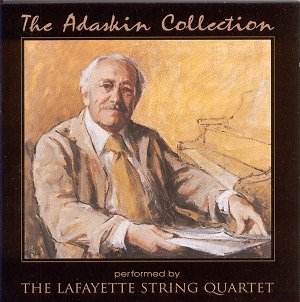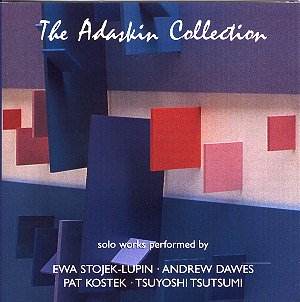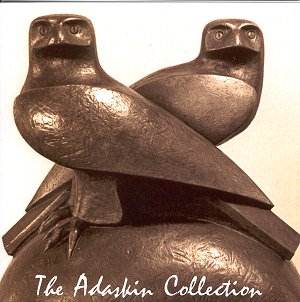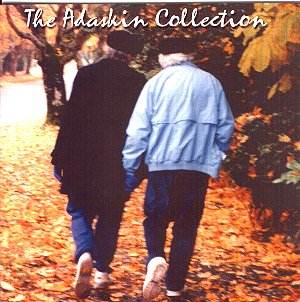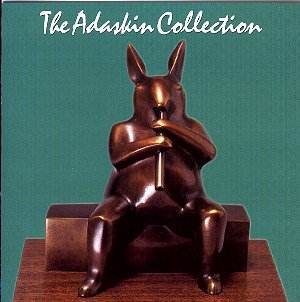The violinist, composer and teacher Murray Adaskin
died in August 2002 at the age of ninety-six after a distinguished career
in the musical life of his native Canada. He played violin in orchestras
for silent films in Toronto, was a member of the Toronto Symphony from
1922-35, and was violinist in the Royal York Hotel Trio from 1938 to
1952. In 1952 he moved to Saskatoon to become head of music at the University
of Saskatchewan. He was conductor of the Saskatoon Symphony Orchestra
from 1956-1960, and was appointed composer-in-residence at the university
in 1966, finally retiring in 1972. Adaskin became one of the first major
composers to be based in Western Canada when he moved to Victoria in
1973 and continued to compose and teach. More than half his works were
written in Victoria.
He composed about 130 works between the post-war years
and his retirement in 2000. Most of his music is instrumental, although
there is some vocal work including his one-act opera Grant, Warden
of the Plains. His final work, Musica Victoria (featured
here in Volume 5), was written in 2000. His music has been widely performed,
broadcast, recorded and admired since the 1950s. He was an influential
and charismatic teacher and thousands of students took his music appreciation
classes at the University of Saskatchewan. He was also a founding member
of the Canadian League of Composers in 1951 and an associate composer
of the Canadian Music Centre.
Adaskin composed pieces for young musicians and for
special occasions, organized concerts and festivals, adjudicated competitions,
and served on cultural committees and boards. He was responsible for
the purchase of a quartet of Amati instruments for the University of
Saskatchewan, instruments played for many years by Victoria's Lafayette
String Quartet (as on Volume 1), an ensemble with whom he had a close
association. The university didn't want to buy the violins, which at
the time were worth $10,000, and are now valued at $5 million. Adaskin
was named an Officer of the Order of Canada in 1980, and received six
honorary doctorates.
A couple of years ago Adaskin recalled how his teacher
Darius Milhaud congratulated his pupil on receiving a telegram from
a Canadian listener which asked ‘Have you seen a psychiatrist?’ after
hearing his Suite for Orchestra. As Milhaud pointed out, ‘This shows
that Canadians are reacting to your music’. From the evidence of these
five CDs (each a separate entity lasting under just 50 minutes, and
not a boxed set) there’s not much to see a psychiatrist about. To use
the word ‘old-fashioned’ to describe Adaskin’s music may be deemed to
be a snub, but nothing like that is intended. Certainly in terms of
late 20th century styles it remains conventional, often using
dance forms, jazz, lilting melodies, common Italian terms for its tempo
indications, and emotional Romanticism. A good starting point to familiarise
yourself with the Adaskin style is the first disc with the two string
quartets, especially the later one written for the players featured
here with their four Amati instruments. Another highly enjoyable work
is the Sonatine Baroque (curiously included on both the second and fifth
volumes) for solo violin. Adaskin clearly enjoys writing works for accompanied
instruments and does it well, and Andrew Dawes is a fine player, especially
the viola-like sounds of his violin’s low register, while Pat Kostek’s
performance of the Vocalise for solo clarinet has wit, colour and technical
expertise.
The String Octet is a very brief affair at four minutes,
but no less effective for that, and as an occasional work it opens with
a fanfare followed by a moving middle section and concluding with a
rather witty passing reference to Beethoven’s fifth. His sonatas with
piano accompaniment divide their labours evenly, and it must be said
he writes extremely well for the piano and for string instruments (in
particular and unsurprisingly the violin). He clearly seems to have
favoured instrumental music, either for soloists or for small ensembles,
throughout his career, though the orchestral catalogue is apparently
substantial too. There are many distinctive themes and imaginative ideas
in his second violin sonata, and original textures in his scoring of
the entertaining Divertimento (one of nine carrying this title) for
two cellos. The String Quintet also gives equal prominence to its five
players, notably including the double bass which so often plays an also-ran
role supporting its string colleagues (including Schubert’s Trout
Quintet), but Adaskin, at the impressive age of 90 when he wrote it,
did have that fine player Gary Karr in his sights. As an example of
Adaskin’s readily accessible style this is as good as it gets and the
playing is excellent.
On the fourth disc there is a risk of sameness not
only to the style but also the instrumental combinations, but having
said that, it would be a pity to miss the brief but hauntingly lovely
Daydreams for alto saxophone creamily played by Erik Abbink to
a discreet piano accompaniment by Jacqueline Perriam. The fifth volume
spans virtually his entire composing career from 1952 to 2000 and mixes
works for strings and for woodwinds. Adaskin is nothing if not consistent,
always intent on appealing to a broad audience and making no attempt
to follow compositional fashion, eschewing innovation and largely avoiding
the twelve-note system or taking other avant-garde routes. The second
movement of the first wind quintet shows his training with Milhaud,
a Gallic wit and subtlety in its rhythms, and short germinal musical
ideas developed in relatively short phrases, the finale its most attractive
movement. With Musica Victoria we are, in terms of scoring, exactly
at Schubert’s Trout Quintet mentioned earlier. The ensemble combination
is typical of the old Viennese coffee-house tradition, and at 95 Adaskin
produced this, his last and highly compelling work, with its wistful
tunes, gentle rhythms and translucent textures. It is given a lovingly
paced performance by the salon quintet.
Murray Adaskin’s name may not be familiar to many outside
Canada or North America, but judging from these five CDs it should be.
He was clearly a craftsman of the highest order, he had something to
say and communicated it with care, humanity and sensitivity to the ears
of his audience. If you like the style you will be hooked.
Christopher Fifield
see also In Memoriam
Murray Adaskin
CONTACT
Canadian Music Centre
20 St Joseph St
Toronto, OntarionM M4Y 1J9
http://www.musiccentre.ca/CMC/dac_rca/BiosSet.html
also available at
AdLar Publications
3020 Devon Road
Victoria, BC
Canada V8R 6C9
adaskin@print.ca


